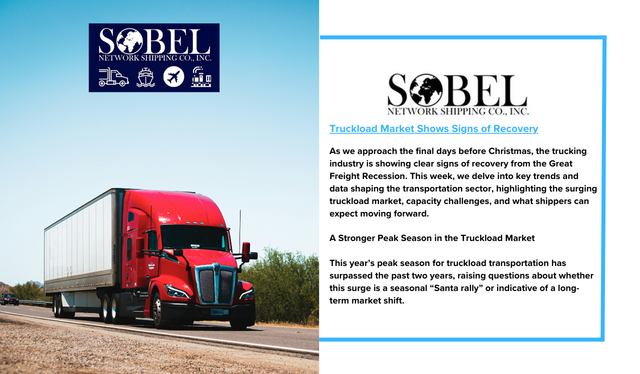As we approach the final days before Christmas, the trucking industry is showing clear signs of recovery from the Great Freight Recession. This week, we delve into key trends and data shaping the transportation sector, highlighting the surging truckload market, capacity challenges, and what shippers can expect moving forward.
A Stronger Peak Season in the Truckload Market
This year’s peak season for truckload transportation has surpassed the past two years, raising questions about whether this surge is a seasonal “Santa rally” or indicative of a long-term market shift. Early signs suggest a recovery, with the freight market bottoming out in May 2023 and gradual improvements becoming evident by mid-year. While the real surge in activity took off post-election, the broader implications point toward a tighter and more competitive market.
Rising Rejection Rates Reflect Capacity Constraints
Recent data reveals an interesting paradox: despite a drop in overall freight volumes, rejection rates have climbed significantly. This trend underscores a critical capacity shortage as carriers exit the market. The Outbound Tender Reject Index (OTRI) has risen from 4.5% in October to 6.5% by mid-December, breaking the typical seasonal pattern of stable or declining rejection rates. This is not merely a seasonal fluctuation; it reflects a diminishing trucking capacity.
Over the past two years, more than 350 net carriers have exited the market weekly, creating a historic tightening of capacity. As available trucking resources shrink, carriers are becoming more selective about the loads they accept, leading to higher rejection rates and forcing shippers into the more expensive spot market.
Shippers Adjust to Market Tightening
In response to these challenges, shippers are adjusting their strategies. Contract rates are beginning to rise, signaling that the recession’s bottom is likely behind us. Mini-bids and freight repricing have become common as shippers prepare for potentially higher transportation costs in 2025. Spot rates, which have surged to $2.52 per mile—the highest in two years—are further evidence of a market favoring carriers.
The Impact of “Carrier Revenge”
As carriers gain leverage, the concept of “carrier revenge” has emerged. This scenario sees carriers prioritizing shippers with better relationships and more favorable contract terms while sidelining those perceived as challenging. Shippers relying heavily on volume discounts may face unreliable service and higher costs in the spot market. Building strong partnerships with carriers will be crucial for navigating this evolving landscape.
RXO Insights: Data Points to Market Transformation
Data from RXO provides valuable insights into current market dynamics. Truckload rates for Q3 were 5.8% to 6% higher year over year, driven by rising operational costs and constrained capacity. Analysts predict that market fundamentals will continue tightening through 2024, with spot rates climbing and contract rates expected to follow suit. This shift sets the stage for a more carrier-driven market in the coming years.
Challenges in the Freight Landscape
The trucking industry has faced significant turbulence, with high-profile bankruptcies such as Kal Freight highlighting the financial pressures on carriers. Allegations of fraudulent practices, such as double-pledging trucks as collateral, have added to the industry’s challenges. Meanwhile, intermodal volumes have defied seasonal trends, reflecting shippers’ efforts to mitigate risks by using rail as a “warehouse on wheels.”
Preparing for 2025: Strategic Recommendations for Shippers
Looking ahead, shippers need to be proactive in navigating market volatility. Key considerations include:
- Securing Long-Term Contracts: Locking in capacity at higher contract rates can mitigate the risks of relying on the spot market.
- Building Strong Carrier Relationships: Collaborative partnerships can help ensure consistent service.
- Monitoring Market Trends: Leveraging data insights will be crucial for adapting to dynamic market conditions.
- Preparing for Policy Shifts: Geopolitical developments and potential tariff changes may impact freight flows and costs.
As the freight market continues to evolve, staying informed and agile will be essential for shippers and carriers alike. The signs of recovery are promising, but the challenges ahead demand strategic planning and flexibility.


